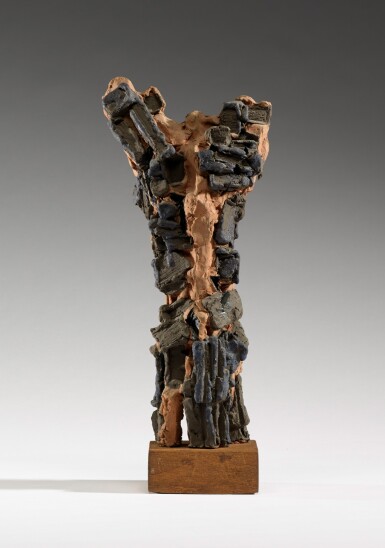Contemporary Art | Milan
Contemporary Art | Milan

PROPERTY FROM AN IMPORTANT PRIVATE ITALIAN COLLECTION
LEONCILLO | TEMPO FERITO
Lot Closed
June 16, 02:22 PM GMT
Estimate
50,000 - 70,000 EUR
Lot Details
Description
PROPERTY FROM AN IMPORTANT PRIVATE ITALIAN COLLECTION
LEONCILLO
1915 - 1968
TEMPO FERITO
signed with cachet at the base
semi-refractory terracotta and glaze
Executed in 1963
This work is accompanied by a certificate issued by Enrico Mascelloni and it will be published in the forthcoming Catalogue Raisonné.
(fimato a cachet alla base
terracotta semirefrattaria e smalti
Eseguito nel 1963
L'opera è accompagnata da certificato rilasciato da Enrico Mascelloni e verrà inclusa nel Catalogo Ragionato di prossima pubblicazione.)
cm 48x22,5x12; inches 18.89 by 8.85 by 4.72
Including the base (con la base): cm 55x22,5x13,5; inches 21.65 by 8.85 by 5.31
To view shipping calculator, please click here
Leonardi Collection (The Artist's family), Umbertide
Galleria Arco Farnese, Rome
Acquired from the above by the present owner (Ivi acquistato dall'attuale proprietario)
Francesco Guzzetti, Leoncillo Leonardi, New York 2016, pp. 21-22, 26, illustrated in colour
Rome, Galleria Il Segno, Leoncillo, 1978
Rome, Galleria d'Arte Moderna e Contemporanea, Leoncillo, 1979, p. 80, n. 78
The cycle of works titled 'Tempo ferito', created by Leoncillo between 1960 and 1964, is at the centre of his final executions. Together with the various 'San Sebastiano' pieces, modeled in the same years, they are certainly among his best-known works and those most representative of his artistic language. The work in question is characterised by the recurrent 'Y' shape and by an idiosyncratic and strongly gestural style, contrasted by a 'brick' armour, as Leoncillo himself calls the blocks of material that cover part of the sculpture.
For Leoncillo, therefore, sculpture also becomes a work about time, a dramaturgy of the human condition, so much so that the reflection on this cycle of works and the melee with the impacified material of each of them become so profound that the term 'time' is probably the most recurrent in his private diaries. Furthemore, the entire cycle is the most commented on in the pages of his Piccolo Diario: " I have begun work on 'Tempo ferito’ (Wounded time); I think perhaps I will title the sculpture thus. Similar days, one after another. Different days, outstretched, tight: four five six, then a big one (in fact every now and then there is a bigger day). They accumulate, creating a tempo, a tight equal-unequal rhythm. In the middle a large crack forms and gets lost in them. Like an ancient ruin, the bricks placed next to one another, are suddenly swallowed by a crack that unites them all." (Leoncillo, in Piccolo diario, 1957-1964).
Il ciclo di opere titolato “Tempo ferito”, realizzato da Leoncillo tra il 1960 e il 1964, è al centro della sua produzione ultima. Insieme ai vari “San Sebastiano”, modellati negli stessi anni, è certamente tra i suoi esiti più noti e tra quelli maggiormente capaci di riassumerne il linguaggio. L'opera in esame è infatti caratterizzata dalla tipica forma a “Y” e da un modellato nervoso e fortemente gestuale, placato da una sorta di armatura di “mattoni”, come Leoncillo stesso chiama i tasselli di materia che rivestono una parte della scultura.
Per Leoncillo anche la scultura diventa dunque lavoro del tempo, drammaturgia della condizione umana, tantochè la riflessione su questo ciclo di opere e il corpo a corpo con la materia impacificata che costruisce ognuna di esse, si fanno talmente profonde che il temine “tempo” è probabilmente quello più ricorrente nei suoi appunti privati. D'altra parte l'intero ciclo è il più commentato nelle pagine del Piccolo Diario: “Ho cominciato Tempo ferito, forse chiamerò così questa scultura. Giorni uguali, uno accanto all'altro. Giorni diversi, distesi, fitti: quattro, cinque, sei poi uno grande (infatti ogni tanto c'è un giorno più grande). Si accumulano, fanno un tempo, un ritmo fitto uguale-disuguale. In mezzo una grande crepa che entra e si perde in essi; come un rudere antico, i mattoni messi uno accanto all'altro, a un tratto mangiati da una piaga che li accumuna tutti” (Leoncillo, in Piccolo diario, 1957-1964).
We kindly thank Enrico Mascelloni for the information he generously provided about this work.
Ringraziamo Enrico Mascelloni per le preziose informazioni che ha gentilmente fornito in merito a quest'opera.
